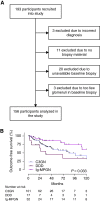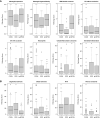Association of Histologic Parameters with Outcome in C3 Glomerulopathy and Idiopathic Immunoglobulin-Associated Membranoproliferative Glomerulonephritis
- PMID: 35777834
- PMCID: PMC9269630
- DOI: 10.2215/CJN.16801221
Association of Histologic Parameters with Outcome in C3 Glomerulopathy and Idiopathic Immunoglobulin-Associated Membranoproliferative Glomerulonephritis
Abstract
Background and objectives: C3 glomerulopathy and idiopathic Ig-associated membranoproliferative GN are kidney diseases characterized by abnormal glomerular complement C3 deposition. These conditions are heterogeneous in outcome, but approximately 50% of patients develop kidney failure within 10 years.
Design, setting, participants, & measurements: To improve identification of patients with poor prognosis, we performed a detailed analysis of percutaneous kidney biopsies in a large cohort of patients. Using a validated histologic scoring system, we analyzed 156 native diagnostic kidney biopsies from a retrospective cohort of 123 patients with C3 glomerulopathy and 33 patients with Ig-associated membranoproliferative GN. We used linear regression, survival analysis, and Cox proportional hazards models to assess the relationship between histologic and clinical parameters with outcome.
Results: Frequent biopsy features were mesangial expansion and hypercellularity, glomerular basement membrane double contours, and endocapillary hypercellularity. Multivariable analysis showed negative associations between eGFR and crescents, interstitial inflammation, and interstitial fibrosis/tubular atrophy. Proteinuria positively associated with endocapillary hypercellularity and glomerular basement membrane double contours. Analysis of second native biopsies did not demonstrate associations between immunosuppression treatment and improvement in histology. Using a composite outcome, risk of progression to kidney failure associated with eGFR and proteinuria at the time of biopsy, cellular/fibrocellular crescents, segmental sclerosis, and interstitial fibrosis/tubular atrophy scores.
Conclusions: Our detailed assessment of kidney biopsy data indicated that cellular/fibrocellular crescents and interstitial fibrosis/tubular atrophy scores were significant determinants of deterioration in kidney function.
Keywords: complement; glomerulonephritis; kidney biopsy; membranoproliferative glomerulonephritis (MPGN).
Copyright © 2022 by the American Society of Nephrology.
Figures




Comment in
-
Prognostication for C3 Glomerulopathy and Idiopathic Immunoglobulin-Associated Membranoproliferative Glomerulonephritis.Clin J Am Soc Nephrol. 2022 Jul;17(7):945-948. doi: 10.2215/CJN.05490522. Clin J Am Soc Nephrol. 2022. PMID: 35777835 Free PMC article. No abstract available.
References
-
- Pickering MC, D’Agati VD, Nester CM, Smith RJ, Haas M, Appel GB, Alpers CE, Bajema IM, Bedrosian C, Braun M, Doyle M, Fakhouri F, Fervenza FC, Fogo AB, Frémeaux-Bacchi V, Gale DP, Goicoechea de Jorge E, Griffin G, Harris CL, Holers VM, Johnson S, Lavin PJ, Medjeral-Thomas N, Paul Morgan B, Nast CC, Noel LH, Peters DK, Rodríguez de Córdoba S, Servais A, Sethi S, Song WC, Tamburini P, Thurman JM, Zavros M, Cook HT: C3 glomerulopathy: Consensus report. Kidney Int 84: 1079–1089, 2013 - PMC - PubMed
-
- Cook HT, Pickering MC: Histopathology of MPGN and C3 glomerulopathies. Nat Rev Nephrol 11: 14–22, 2015 - PubMed
-
- Levy M, Halbwachs-Mecarelli L, Gubler MC, Kohout G, Bensenouci A, Niaudet P, Hauptmann G, Lesavre P: H deficiency in two brothers with atypical dense intramembranous deposit disease. Kidney Int 30: 949–956, 1986 - PubMed
-
- Licht C, Heinen S, Józsi M, Löschmann I, Saunders RE, Perkins SJ, Waldherr R, Skerka C, Kirschfink M, Hoppe B, Zipfel PF: Deletion of Lys224 in regulatory domain 4 of Factor H reveals a novel pathomechanism for dense deposit disease (MPGN II). Kidney Int 70: 42–50, 2006 - PubMed
-
- Jokiranta TS, Solomon A, Pangburn MK, Zipfel PF, Meri S: Nephritogenic lambda light chain dimer: A unique human miniautoantibody against complement factor H. J Immunol 163: 4590–4596, 1999 - PubMed
Publication types
MeSH terms
Substances
Grants and funding
LinkOut - more resources
Full Text Sources
Other Literature Sources
Research Materials
Miscellaneous

